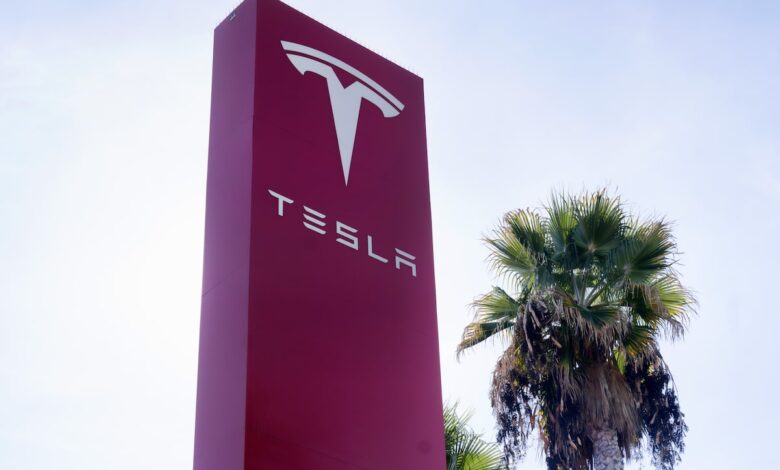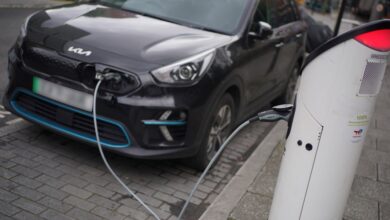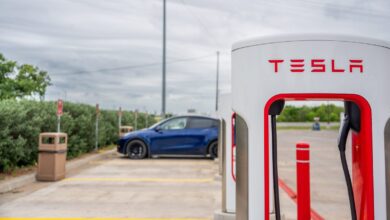Opinion: Tesla layoffs bring the entire electric-vehicle industry into question

Gus Carlson is a U.S.-based columnist for The Globe and Mail.
Talk about an inconvenient truth. After months of trying to explain away the gathering clouds over the electric-vehicle sector as the usual growing pains of an emerging market, the EV faithful swallowed a bitter pill this week when Tesla finally blinked.
The market and spiritual leader of EVs said it will lay off more than 10 per cent of its work force, more than 14,000 people, because of slowing global demand. The company’s deliveries have dropped for the first time in four years, and unsold inventory has swelled to almost 50,000 vehicles.
Tesla’s TSLA-Q stock tumbled on the news, and rumours circulated that the summer launch of its highly anticipated US$25,000 car, meant to compete with low-priced Chinese EVs, would be delayed – rumours Tesla CEO Elon Musk denied.
The glimpse into Tesla’s mortality was a blow to even the most devout EVangelists, many of whom have dismissed anyone who has dared to tell the truth about the ominous signs of trouble on the road to EV nirvana as Luddites with a Chicken Little complex.
While it may be true that the sky hasn’t yet fallen on the progressive vision of EVs for everyone, it sure is getting dark. The bad news out of Austin, Tex., reflects more than a recalibration for Tesla. It is a reckoning that people such as Toyota chairman Akio Toyoda have predicted for some time: EVs will not dominate the global auto market, and the sector may already be testing its limits.
For those who have been paying attention, the cooling reflected in the Tesla layoffs should come as no surprise. Cracks appeared last summer when U.S. car dealers reported that almost 100,000 unsold EVs had piled up on their lots, more than twice the industry average for inventory.
This year started with a thud. Fisker, the pure-play EV maker lurching toward bankruptcy, was delisted by the New York Stock Exchange and is now a penny stock on the over-the-counter market. Rivian, whose quality issues earned it a place on Consumer Reports’ list of worst car brands of 2024, just told investors it won’t increase shipments this year. Lucid beat delivery expectations for the quarter, but only after deep price cuts that investors fear will hurt margins. And we’re talking small numbers – fewer than 2,000 cars were shipped.
The Big Three North American automakers, meanwhile, have braked hard on their EV plans. Earlier this month Ford delayed EV production at its Oakville, Ont., plant for two years, putting 2,700 jobs and billions of dollars in investment into doubt. This follows the shutdown of production of its F-150 Lightning EV pickup trucks in Michigan, which brought hundreds of layoffs and a redeployment of resources.
The reasons are well-documented. EV prices have tended to be significantly higher than those of gas-powered or hybrid models. Range anxiety has been exacerbated by the slow build-out of charging infrastructure. In the United States, a multibillion-dollar federal program launched three years ago to develop a national network of charging stations had built just one as of the end of last year.
And as rental-car giant Hertz discovered recently, the costs of maintaining, repairing and insuring EVs are significantly higher.
After investing heavily in EVs, the company put 20,000 almost-new EVs up for sale because of soft customer demand and pulled back on plans to convert its entire fleet to electric by mid-decade. Its CEO was subsequently canned.
And then came the Tesla bombshell. When the deep-pocketed beacon for the industry’s future puts it in reverse, even the thirstiest EV Kool-Aid drinker is bound to do a spit take.
To be sure, every emerging sector, especially one that requires massive changes in infrastructure and consumer behaviour, sees players come and go. And like any market that has experienced red-hot growth, the EV market needs a breather and a recalibration.
As for those pesky reliability issues plaguing many brands, well, they’re just growing pains. Every early adopter expects a few bugs.
The bugs, however, have become bigger than breadbaskets – big enough to bite Tesla. Even Mr. Musk’s glass-half-full suggestion that the layoffs would position the company for its next phase of growth runs counter to global consumer trends.
Somewhere, Mr. Toyoda must be feeling some vindication for his prescience. After all, he lost his job at one point because activist progressive investors objected to his refusal to bet the farm on EVs.
Instead, he pursued a multiplatform strategy that included hybrids, alternative fuels, gas and electric vehicles.
That strategy was based not on political virtue signalling but on the fact there are huge chunks of the world’s population who don’t have – and never will have – access to reliable electricity, so the EV market at its peak will account for just 30 per cent of the global auto market.
Now, 30 per cent of a market expected to reach US$4-trillion by 2030 isn’t chicken feed. It’s certainly enough incentive to push the EV industry to continue to innovate.
But with evidence mounting that Mr. Toyoda’s perspective has validity, it’s about time to temper the cheerleading and start telling the truth about EVs, as inconvenient as it may be.



